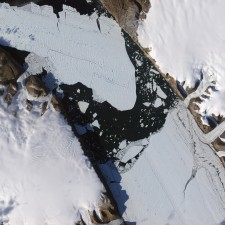Oceans and Ice
Are We Facing a Meltdown?
The polar ice caps are one of our planet’s defining features. Data and models suggest that as the Earth warms the poles warm by roughly twice the global mean, making polar ice cover particularly vulnerable in a warming world. Ice in the high Arctic interior (north of 80N) is especially at risk because, in contrast to the Antarctic interior, it has no land beneath it. Arctic ice cover comprises sea ice, and when this ice melts, it exposes the ocean below. The dark surface of the sea is much better at absorbing heat than ice, which causes the Arctic waters to warm more quickly, which causes more ice to melt, and so on. Over the past several decades, Arctic sea ice has been thinning and retreating.
Changes in the planet’s two large polar ice sheets have the potential to raise sea level by many meters should ice sheets break off and melt into the oceans. Will warming ocean waters in contact with the ice sheets speed the process of land ice calving off and thus accelerate the rate of sea level rise? Scientists have seen drastic changes in ice sheets over Antarctica and Greenland in just the last two decades.
Despite its evident importance, the relationship between ice, oceans, and climate is poorly understood. Researchers at MIT and WHOI are trying to uncover the mechanisms that connect the polar oceans to our planet’s climate. We are trying to determine how vulnerable the polar oceans are in a warming world, to what extent the changing oceans may trigger changes in the ice sheets, and how the interaction of oceans and ice will shape the future climate. Particular emphasis is being placed on the development of techniques to observe polar ocean and ice fields and of models that can synthesize those observations and make projections about future change.





